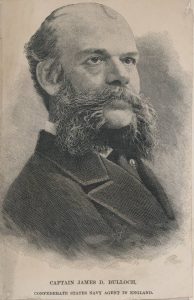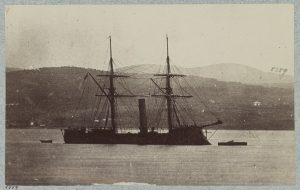Symposium Spotlight: Goals of the Confederacy’s European-Built Ironclad Fleet
With less than three months remaining until our symposium, several of our authors will further explore topics relating to their ‘What If’ theme. Today, Neil Chatelain explores why the Confederacy wanted to build ironclads in Europe…

A few weeks back the Emerging Civil War question of the week asked what made the US capture of New Orleans in the spring of 1862 a turning point (check out that ECW question of the week here). One of the comment discussions focused on whether the Confederacy desired or planned to recapture the Crescent City. The answer is yes. One such plan was focused on the other side of the Atlantic and would rely on a squadron of ironclads building in Great Britain and France. A brief dive into the construction and standing orders of this proposed ironclad squadron can contextualize the question of the Confederacy recapturing New Orleans.
The Confederacy contracted for five European ironclads, the two English-built Laird rams, two French-built ironclads, and one Scottish-built frigate. They also acquired numerous commerce raiders and government-owned blockade runners and contracted for four steam corvettes to support an ironclad squadron. The Scottish frigate was massive. It was heavily armed with 20 cannon, but required a crew of 500 sailors and was too large to enter Confederate harbors. Realistically, it was a poor design choice that would never be fully realized.
The other four ironclads however had specific requirements for size, displacement, and draft to meet Confederate Navy Secretary Stephen Mallory’s vision of using a European-built fleet to break the blockade and recapture New Orleans. “Not a day, not an hour, must be lost in getting these ships over, and money is of no consequence in comparison to the speedy accomplishment of this work,” Mallory told his agents in England. “If we can succeed in getting them [the European-built ironclads] to sea, armed, manned, and equipped we would go to New Orleans at once and regain the Mississippi.”[1]

With that guidance, Mallory’s chief ship acquisition officer, Commander James Bulloch, set to work to realize the sectary’s vision. In 1862 he contracted with the Birkenhead yard of John Laird and Sons for two ironclads, best known as the Laird rams. These were specifically designed with a fully loaded draft no more than 17 feet, meaning they could navigate Confederate ports and the Mississippi River (carefully!). To meet these requirements, the Laird rams were smaller compared to the oversized Scottish frigate. They housed only four cannon, mounted as pairs in two rotating turrets that used a competing design to that of USS Monitor, and were envisioned for crews of 150 officers and men.
Bulloch always kept Mallory’s goal of recapturing New Orleans in his mind and as construction efforts continued, he alluded to what the ironclad squadron should accomplish. Regarding the Laird rams, Bulloch believed they could easily enter the Mississippi River and “force their way past the forts” protecting New Orleans “and steam up to the city.” They would either destroy the US squadron defending New Orleans outright or force its retreat, speculating that the city’s isolated garrison would “retire upon the lake [Lake Pontchartrain], and escape by means of their transports.”[2]
Mallory agreed with this action plan. In May 1863, he wrote Bulloch reiterating such: “The President has selected you as the agent of the Government” and “it is deemed expedient to leave to your judgment, untrammelled by instructions, the size and details of the vessels, subject to the consideration that in draft of water, speed and power, they must be able to enter and navigate the Mississippi river.”[3]

Mallory also told Bulloch that regarding France, “the immediate possession of two or three good armoured ships, capable of entering the Mississippi, would be of incalculable value.”[4] By mid-1863, Bulloch contracted for two more ironclads with Bordeaux shipbuilder Lucien Arman. These were even smaller than the Laird rams, mounting three cannon, one forward and two in a single fixed iron turret. The commander wrote in his detailed memoir that these two ships “were of small size, and were designed for operations in the Mississippi river and the shoal harbours of the Gulf coast of the Confederate States. Their draught in their best fighting trim was to have been fourteen feet.”[5]
This squadron of proposed ironclads even had standing orders. Mallory provided directives to Captain Samuel Barron, assigned to command the Confederacy’s naval forces in Europe. Regarding the ironclad squadron Barron would personally command, Mallory advised: “If you could raise the blockade of Wilmington, an important service would thereby be rendered, a service which would enable neutrals to carry a great deal of cotton from that port. The dispersion of the blockading fleet however, and the raising of the blockade would have to be so unquestionable and clear that human ingenuity would fail to invent a denial of it, for upon a very flimsy foundation the enemy would dispute it.”[6] Once the blockade was broken the ironclads could resupply before undertaking Mallory’s dreamed of reconquest of the Mississippi River valley.
Of course, this is just what was envisioned. Only one of the ironclads, the French-built CSS Stonewall, flew the Confederate flag, surrendering in Cuban waters in May 1865 without ever reaching the Confederacy. At the 2022 Emerging Civil War Symposium, I will provide a deeper glimpse at how the Confederacy tried getting these ships to sea and how the United States successfully stopped them with their diplomatic corps. I will also take a realistic look at whether the Confederacy could have used these ironclads to break the blockade and ultimately realize Stephen Mallory’s goal to “regain the Mississippi.”[7]
Find more information on our 2022 Symposium, and purchase tickets, by clicking here. Ticket quantities are limited!
[1] ORN, Series 2, Vol. 2, 271.
[2] James D. Bulloch, The Secret Service of the Confederate States in Europe: or How the Confederate Cruisers were Equipped, (New York: G.P. Putnam’s Sons, 1884), Vol. 1, 410.
[3] Ibid., Vol. 2, 31.
[4] Ibid., Vol. 2, 36.
[5] Ibid., Vol. 2, 75.
[6] ORN, Series 2, Vol. 2 593.
[7] Ibid., Series 2, Vol. 2, 271.

Jefferson Davis gave his brother-in-law, Richard Taylor, a command in western Louisiana. His secret orders were to re-captured New Orleans.
I want to add that I just finished a novel in which England sends the two laird rams out of the country and United States vessels sink them. This leads to a world war
looking forward to the presentation!
I am looking forward to presenting it! Find me at the symposium and we can chat about it for sure.
Great Britain realized that to build ships for the Rebels, risked war with the United States. That’s way they came to their senses, and ordered that the construction stop.
Interesting that the above report claims: “Mallory’s goal of recapturing New Orleans was [a consideration during construction of the Laird rams.]” Because, there was a problem: both rams had a draft of 17+ feet. The USS Hartford (Farragut’s flagship) also had a draft of 17 feet, and it took four days, and considerable removal of guns and ammunition, to work her across the bar blocking the mouth of the river in March 1862 while the Mississippi was in flood. The Laird rams would not have enjoyed the luxury of time or lightening, if they were to be effective in the river.
I would be interested to see if this becomes a full-length article. I think there is considerable interest outside ECW circle,.